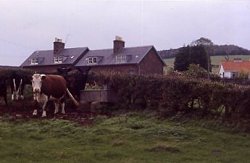Arable Farming – Intensive
The East Lothian lowland plain is one of the largest areas of high quality, high yielding farmland in Scotland. The land capability of the deep fertile soils in this area renders it suitable for growing a wide range of crops and vegetables. Land nearest the coastline, about 50′ above sea level, is comprised of deep well drained sandy loams. These soils are easily worked, capable of being harvested all year round, and produce consistently high yields. However, due to the lighter texture of the soil, the climatic effect of long hot spells during spring and summer can result in the necessity for irrigation for some crops. Further inland the soil is of a heavier nature with high clay content. Although marginally more difficult to work this soil has good moisture retentive properties making it capable of producing excellent crop yields.

During the early years farms were run on a traditional six-crop rotation of potatoes, wheat, grass/turnips, barley and two years’ grass. Sugar beet was widely grown as a high value break crop but after the closure of the sugar beet factory at Cupar, Fife in 1972, the market disappeared and none was grown thereafter. Fields of cabbage, brussel sprouts and cauliflower were also produced as useful break-crops, but these were largely replaced in later years by increased acreages of other cereal crops. Potato growing was concentrated mainly on the coastal area around Aberlady and on the redstone loams near Dunbar. Latterly, with the high level of mechanization and excellent transportation equipment, acreage of suitable land was contracted out for potato production to potato growers on an annual basis throughout the county. Oil seed rape was introduced to crop rotations in the 1970s, with E.E.C. subsidies to encourage farmers to grow it. Although expensive to grow, it was a profitable cash crop and large areas of bright yellow flowers brightened up the landscape of East Lothian in spring each year. However, from the mid 1990s, high inputs and a sharp drop in returns saw a reduction in the acreage sown. By 2000 set-aside, introduced by the EU in 1992, accounted for 10.3% of the total cropped area of the county.
Silage and hay were produced as fodder for store cattle bought in the autumn and fattened over the winter. Here too, dwindling product prices, increased regulations and the effects of the B.S.E. crisis in 1996 led to some farmers moving out of livestock completely in favour of cereals. To combat declining profits and falling incomes in the last few years of the century, farmers increasingly diversified into other areas, in an effort to reduce financial pressures.
Inland – Mixed Farms

Inland from the northern plains, to a height of about 500′, farming is less intensive. Land at this level is of a marginally steeper contour with a greater range of soil type, structure and texture, and, with the variable nature of the climate, crop yields may vary from year to year. However, with careful timing of cultivation, sowing and harvesting this land is capable of producing high yields of cereals. By 2000, cropping was predominantly wheat, barley and grass with some oil seed rape and potatoes. Peas and beans were also produced on some farms. Although oats still featured, changes in farming practice and low returns resulted in a sharp decline in the acreage sown.
Cattle and sheep were an important addition to farming in this area. There was a traditional pattern of buying store cattle from elsewhere in the country to be finished on East Lothian farms. This trade still continued to 2000, but stock was kept in larger units on fewer farms. In the early part of the period large numbers of Irish cattle were imported for fattening, many destined for East Lothian farms, but over the years this practice gradually declined. Herds of beef suckler cows increased in the county over the period, and remained at a consistent level of over 5200 from 1975-2000. Between 1965 and 1970, the importation of continental cows largely replaced the more traditional breeds of Shorthorn, Aberdeen Angus and Blue-Grey.